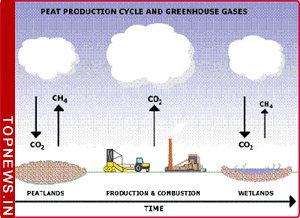Methane more stable in a warming world than previously thought
 Washington, April 24 : In a new research of ice cores by scientists, it has been revealed that a vast, potential source of the potent greenhouse gas, methane, is more stable in a warming world than previously thought.
Washington, April 24 : In a new research of ice cores by scientists, it has been revealed that a vast, potential source of the potent greenhouse gas, methane, is more stable in a warming world than previously thought.
The finding includes Australian contributions from CSIRO and the Australian Nuclear Science and Technology Organisation (ANSTO).
Wetlands in the tropics and emerging from under receding Northern Hemisphere glaciers have been considered the primary source of rising atmospheric methane in a warming world.
But, scientists have known of another potential source.
Massive quantities of methane are locked away in permafrost and in the ocean floors as methane clathrate - an ice-like material which can return to gas if temperatures increase or pressures drop.
Just a 10 per cent release of methane would have the equivalent impact on global warming of a ten-fold increase in carbon dioxide (CO2) concentration.
So began a US, New Zealand and Australian research project to understand ice core records spanning hundreds of thousands of years, profiling periods of high-methane increase and focusing on the Younger Dryas period.
The cause of the large increase in methane 12,000 years ago as the Earth warmed and the Younger Dryas ended has been a source of much debate among scientists.
"The result is a good news outcome for climate scientists monitoring greenhouse gases and investigating the likely sources of methane in a warming world," said CSIRO's Dr David Etheridge, from the Centre for Australian Weather and Climate Research, who helped show how the air could be extracted from polar ice to measure past methane changes and identify their causes.
"There are vast stores of methane clathrates beneath the ocean and in permafrost and there is evidence that millions of years ago release from these storages caused significant climate change, although none in more recent times," he added.
"The objective of the research was to determine how stable the clathrate methane stores were as the Earth warmed rapidly from its last glacial state and whether clathrates might be a source of future climate change as global temperatures rise," he explained.
"We know that emissions of methane are increasing now and that some sources might emit even more with warming, causing a positive climate feedback, or amplification. But this finding suggests that the clathrate source is less susceptible than recently feared," Dr Smith said. (ANI)